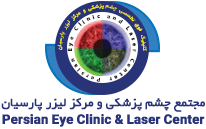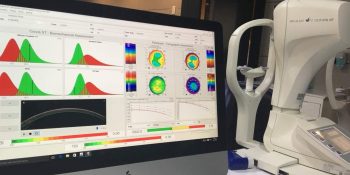Abrrometry
Aberrometry way of measuring optical system refers to unwanted disturbances. The optical system usually comes in a combination of multiple lenses. But if we consider it to be a simple convex lens, we can better explain these abnormalities, which are called aberration or distortion.
In a perfectly convex lens with no distortion, if a parallel light is shifted to one side, it focuses on the other side of the lens, which is the focal point of the lens and creates a clear image of light or object. This is an ideal refractive lens. But lenses and optical systems, including the human eye, are usually not ideal and are not defective, and may have unwanted distortions.
In a convex lens with curvature and a refractive index of uniformity, parallel light focuses on several points instead of focusing on a point or a surface, the focal length of the lens. The light that shines in the lens environment focuses on the surface closer to the lens, and the central lights focus on the next level. In fact, the surroundings of a spherical lens have more refractive powers than the center, and consequently create a distorted image; this type of distortion is called spherical aberration. To address this problem, lens cameras and advanced systems are designed to refine light in the center and in the environment of one species. These lenses are called aspheric. Various types of distortion have their effects on optical systems that use a combination of lenses, such as the eye and telescopes. Spacer lenses and other mechanisms are used to correct distortions in telescopes. Correcting distortions requires devices that can detect them and measure their magnitude. Buoyantly, these devices are available nowadays and are widely used in ophthalmic eyes.
Distortion defects must be distinguished from refractive errors. If the human eye has a refractive error or so-called weak, all of the images are formed on the front or back of the retina, causing a near-vision or camera illness. These diseases can be corrected with glasses, lenses, or laser surgery, but if refractive errors are eliminated by these methods, usually the lesions remain and sometimes intensify, and despite increased visual acuity, poor quality of vision, or loss of vision will find. In the past, Laser and Laser devices were only able to correct refractive errors, but today, advanced devices are also capable of correcting aberrations, due to devices that can measure these distortions. Astronomical devices simultaneously measure distortions, refractive errors, and transmit data to an eximer laser device, with both types of correction. The simultaneous treatment of refractive errors and distortion disorders is called the Customize method, which means that the treatment is designed and performed on the basis of the optical characteristics of the eye of each patient. In this way, corneal irregularities and lenses can be corrected.
Parsian subspecialty ophthalmology clinic was one of the first centers in the country to be equipped with Eye Aberration Measurement and Correction technology, and the laser devices of this center, by connecting to Abberomentery, are able to measure and correct these disorders with refractive errors.





